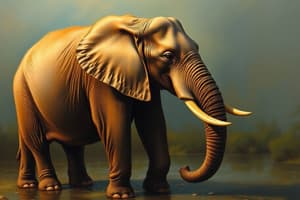Podcast
Questions and Answers
What are tusks made of and what are they used for?
What are tusks made of and what are they used for?
Tusks are made of ivory and are used for foraging, digging, and fighting.
How does an elephant's skin help protect it?
How does an elephant's skin help protect it?
Elephants have thick, wrinkled skin that acts as a barrier against sunburn, insect bites, and water loss.
Describe an elephant's dental structure and how it is adapted to their diet.
Describe an elephant's dental structure and how it is adapted to their diet.
Elephants have six molars in each jaw that are continually worn down and replaced as part of the process of hypsodonty, which helps in processing tough fibrous plant material.
How often do elephants typically mate, and what is the gestation period for a calf?
How often do elephants typically mate, and what is the gestation period for a calf?
What physical changes do elephant calves undergo after birth?
What physical changes do elephant calves undergo after birth?
What is one of the prominent conservation initiatives mentioned in the text?
What is one of the prominent conservation initiatives mentioned in the text?
How does the unique digestive system of elephants impact their dietary habits?
How does the unique digestive system of elephants impact their dietary habits?
Why do elephants consume more bark and woody plant materials during periods of drought?
Why do elephants consume more bark and woody plant materials during periods of drought?
How do conservation efforts engage local communities in protecting elephants?
How do conservation efforts engage local communities in protecting elephants?
What role does habitat restoration play in elephant conservation?
What role does habitat restoration play in elephant conservation?
Flashcards are hidden until you start studying
Study Notes
Elephants: Unpacking Their Physical Traits
Elephants, the largest living land animals, enchant us not only with their intelligence and complex social behaviors but also with their unique physical characteristics. Let's delve into the fascinating details of their impressive anatomy and physiology.
Size and Weight
Elephants come in two species: the African bush elephant (Loxodonta africana) and the Asian elephant (Elephas maximus). The African bush elephant is the larger of the two, standing up to 3.5 meters tall at the shoulder and weighing between 1,800 and 6,000 kilograms. The Asian elephant, on the other hand, is smaller, reaching up to 3 meters tall and weighing between 2,000 and 5,500 kilograms.
Shape and Structure
An elephant's body is designed for a slow, steady pace, and their limbs are adapted to carry their weight. Their legs are long, with wide feet that help to distribute their weight and provide stability. Elephants have a unique feature called a padded toe, which helps to grip the ground. The feet of an elephant continue to grow throughout their life, providing a larger surface area for walking and bearing weight.
Elephants have a large, powerful trunk that serves many purposes, including smelling, touching, lifting, and drinking. The trunk is an extension of the upper lip and nose, and it is used for manipulating objects and communicating with other elephants. Elephants also have a pair of long, curved tusks that can grow up to 3 meters long. Tusks are made of ivory and are used for foraging, digging, and fighting.
Skin and Hairs
Elephants have a thick, wrinkled skin that serves as an effective barrier against sunburn, insect bites, and water loss. Their skin also contains thousands of sweat glands, which help to cool the animal down in hot weather. Elephants have sparse, bristly body hair that grows from deep in the skin, and their ears have large folds to help dissipate heat.
Teeth
Elephants are herbivores, and their dental structure is adapted to process the tough fibrous plant material they consume. Adult elephants have six molars in each jaw, which are arranged in a circle. These molars are continually worn down and replaced as they move inward in a process called hypsodonty. Elephants can lose their teeth multiple times during their lifetime, and the new molars are formed in the back of the mouth, gradually moving forward as the old molars wear down.
Reproduction and Life Cycle
Elephants typically mate once a year; however, this can vary depending on the species and environmental factors. Female elephants give birth to a single calf after a gestation period of 22 months. Calves are born with a small trunk and no teeth, but they grow quickly and develop their adult features within a few years. Elephants have a long lifespan, with some individuals living up to 70 years in the wild.
Elephants are a fascinating species with unique physical characteristics that have enabled them to thrive in their environments. Understanding their anatomy and physiology can help us appreciate the intricate adaptations that have allowed them to survive and flourish for thousands of years.
Studying That Suits You
Use AI to generate personalized quizzes and flashcards to suit your learning preferences.





